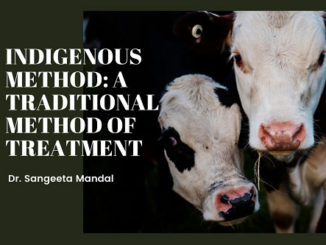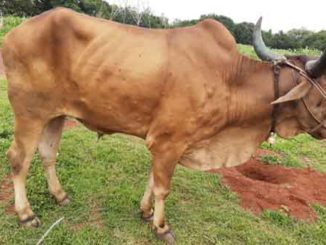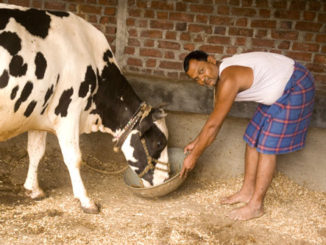Culling is the practice of removing undesirable animal from the herd either by killing or by selling them. There are several reasons to cull the animals although the majority of them are economic in nature. Conditions like deteriorating production, reproduction, poor growth rate, incurable diseases etc. which incur financial loss to the farm necessitates culling. Animals should be culled either once or twice in a year and about 10-20% of the animals are culled on yearly basis. A healthy herd should maintain the culling percentage at less than 20%. By replacing the old animals with new ones, the herd/flock size can be maintained.
Importance of culling
- It helps to maintain the number of animals in the farm by removing the excess undesirable animals.
- It aids in increasing productivity and efficiency of the farm by keeping the healthy good performing animals.
- It leads to more profitability by removing low producing and diseased animal.
- It helps in controlling disease spread in the farm as diseased animals should be separated out from the rest of the herd.
- It assists in managemental practices of the farm.
- Healthy animals benefit the aesthetic beauty of the farm and is more appealed by people.
Types of culling
- Policy culling
- If the animal’s phenotypic characteristics doesn’t match with the true characters of its breed.
- Proper record about its parents or pedigree information is not available.
- Animals with genetic defects like free martin, persistent hymen, spermatozoan aberrations etc. should be culled.
- Animals showing poor production/reproduction performance should be removed from the herd.
- Old aged animals which can no longer be used for breeding purpose or those with gummers and broken mouth. In sheep and goat generally above six years of age culling can be done.
- If animals are underweighted in respect to its age or animals with stunted growth may be culled.
- Animals with defective quarters or teats or surplus animals in the farm which are not useful are recommended for culling.
- Veterinary culling
- Animals suffering from incurable diseases should be culled.
- Animals that have been disabled or are no longer suitable for normal production life
- Weak and disabled (Animals losing weight and having static weight during growing phase or losing 25 percent or more weight during adult hood could be recommended for culling.
- Suspects/confirmed cases of contagious/infectious/zoonotic diseases in animals
- Animals having repeated difficulty in parturition, prolapses or poor conformation of udder, limbs and body should be culled.
- When animals become unsuitable for normal production life, they should be culled.
- Emergency culling
- Animals who have been in accidents, have been attacked by predators, or have a poor prognosis.
- Animals with non-specific diseases that have a poor prognosis.
- Diseases like Tuberculosis, Johne’s disease, Brucellosis etc if confirmed.
- Animals showing consistent poor reproductive performance like failing to breed or repeat breeders, conceive, and produce offspring.
- Weaning light weight, low-grade offspring.
- Lacking ideal conformation, breed traits, or sex characters.
- Developing irreversible physical problems.
- Demonstrate the presence of a hereditary disease.
Criteria to be considered
When making culling decisions, the pregnancy rate is a critical component to consider, and animals with low performance rates or those found open should be moved to the front of the list. The most well-known element to consider is the pregnancy rate, but there are a few other factors to consider as well. Aging, udder scoring, body condition scoring, disposition, eyes, and structure are the factors to consider.
Animals which are barren or open should be eliminated first and those that have difficulty in parturition, as well as those that have prolapsed earlier or have shown that they are prone to a prolapse condition should be culled. Animals having history of abortion should be critically examined for the cause and eliminated from the herd.
Record keeping about the ages, reproduction and production performance can be of help in making animal culling decisions. An animal’s teeth should be checked to see how worn they are and how many are still there. To graze and consume efficiently, animals require teeth. Furthermore, younger animals in the herd should have better genetics than older ones. Animals with broken mouths and badly worn teeth, as well as animals that are young but not superior, should be eliminated.
Cow udder condition is linked to milk production, which impacts calf performance, but the physical structure of the udder might obstruct the calf’s access to milk, resulting in reduced growth despite ample milk. Mastitis is one of the most common health issues of dairy animals which causes damage to the udder and lowers the milk production. Blind teat, missing teat or meaty udder conditions can be considered for culling.
Body Condition Scoring is a good management method for identifying nutritional demands disparities among cows in a herd. BCS scores vary from 1 to 9, with 1 indicating extremely emaciated and 9 indicating excessive obesity. At calving, cows should have a BCS of 5 to 7, and at breeding, they should have a BCS of 5 to 6. Animals that are not in these optimal ranges consume more resources than the 5 to 7 cattle and so spend more money, reducing the operation’s profitability.
Another crucial trait is disposition. One cow with a horrific mind-set can break the dynamic of the complete herd and pose many protection issues. This trait also can be transmitted directly to their offspring and disposition troubles can be there in addition to different overall performance characteristics, all of which decreases profitability and protection.
Monitoring the eyes on a habitual foundation is important. Repeated examinations permit to get acquainted with the ordinary look of the animal which makes recognizing issues a great deal easier. Lacking properly eye sight can cause vision problem in addition to protection concerns.
Conformation of the animal is also of significance. The maximum sorts of lameness are due to problems in arthritic joints and foot and hoof problems like foot rot condition etc. Excess hoof increase can cause curling feet and eventual misalignment of the feet and leg bones.
References
- Culling of Dairy Animals. Animal Husbandry. TNAU Agritech Portal. https://agritech.tnau.ac.in/
- Jody G. Holthaus. (2015). Important factors to keep in mind when culling beef herd. High Plains Journal.
- Singh, R. R. and Islam. Md. M. (2013). Farm Animal Management Principles and Practices. pp 287.






Be the first to comment